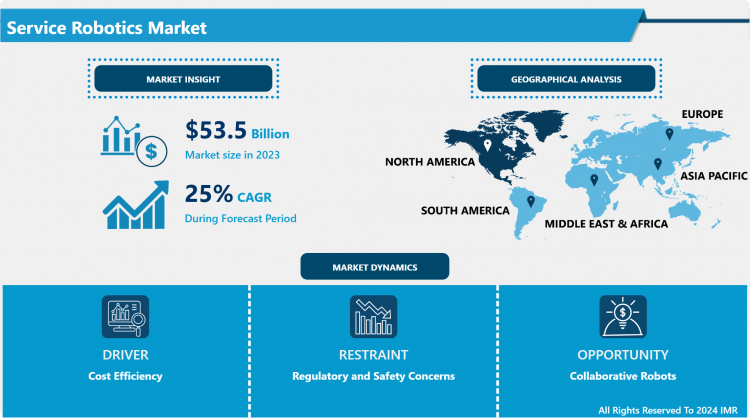Service Robotics Market Synopsis
Service Robotics Market Size Was Valued at USD 53.50 Billion in 2023, and is Projected to Reach USD 398.61 Billion by 2032, Growing at a CAGR of 25.00% From 2024-2032.
The service robotics market encompasses robots designed to perform tasks that assist humans, primarily in non-industrial environments. These robots are deployed in a variety of sectors including healthcare, hospitality, agriculture, and domestic settings, providing services such as cleaning, delivery, caregiving, and entertainment. Service robots are characterized by their autonomous or semi-autonomous capabilities, leveraging advanced technologies like artificial intelligence (AI), machine learning, and the Internet of Things (IoT) to enhance their efficiency and adaptability. This market is driven by the increasing demand for automation, improved operational efficiency, and the need for solutions to address labor shortages and enhance quality of life.
- The service robotics market is experiencing robust growth driven by technological advancements and increasing demand for automation across various sectors. Service robots, which are designed to assist humans in performing tasks, have seen significant adoption in industries such as healthcare, hospitality, and logistics. This growth is attributed to the robots' ability to enhance operational efficiency, reduce labor costs, and improve service quality.
- Key drivers of the service robotics market include the aging population, which necessitates the use of robots for eldercare and medical assistance, and the rapid development of artificial intelligence (AI) and machine learning technologies, which enhance the capabilities and flexibility of robots. Additionally, the rising focus on operational efficiency and cost reduction in various industries is prompting organizations to adopt robotic solutions.
- However, the market faces challenges such as high initial investment costs and concerns related to job displacement. Despite these challenges, the overall market outlook remains positive, supported by continuous innovations and the expanding application of service robots in emerging sectors. The Asia-Pacific region, in particular, is expected to witness substantial growth due to increasing industrial automation and supportive government initiatives.
- In summary, the service robotics market is poised for significant growth, driven by technological advancements and increasing automation needs. While challenges exist, ongoing innovations and expanding applications across various sectors are likely to sustain the market's upward trajectory.

Service Robotics Market Trend Analysis
Growing Demand for Automation in Healthcare, Hospitality, and Retail
- The growing demand for automation is transforming various industries by integrating advanced service robots into their operations. In healthcare, the adoption of service robots is revolutionizing patient care and hospital management. Robots are employed to assist with routine tasks such as monitoring vital signs, dispensing medications, and transporting supplies. These robots enhance the efficiency of hospital operations, allowing medical staff to focus more on patient care rather than logistical tasks. Additionally, robots can assist with surgery, provide rehabilitation services, and support elderly care, improving overall healthcare delivery and patient outcomes. This trend reflects a broader shift towards leveraging technology to address challenges such as labor shortages and increasing patient volumes in the healthcare sector.
- In the hospitality and retail industries, service robots are increasingly becoming an integral part of operations, optimizing processes and enhancing customer experiences. In hospitality, robots are used for tasks like room service delivery, concierge services, and guest check-in, streamlining operations and reducing wait times. This automation not only improves service efficiency but also elevates the overall guest experience. In retail, robots assist with inventory management, shelf stocking, and even customer service roles. They can navigate store aisles, track inventory levels, and provide information to shoppers, making the shopping experience more seamless and interactive. The adoption of service robots in these sectors reflects a growing recognition of their potential to improve operational efficiency, reduce costs, and meet the evolving expectations of customers in an increasingly competitive market.
Enhancing Capabilities with AI and Machine Learning in Service Robots
- The integration of Artificial Intelligence (AI) and machine learning is profoundly enhancing the capabilities of service robots, enabling them to perform increasingly complex tasks with greater efficiency and precision. AI algorithms allow robots to process vast amounts of data in real-time, making informed decisions and executing tasks that were previously beyond their capabilities. For example, in healthcare, AI-driven robots can assist in surgeries by providing precise movements and reducing human error. They can also analyze patient data to offer personalized care and early diagnosis of diseases. In logistics, AI-enabled robots can optimize routes and manage inventories, ensuring timely deliveries and reducing operational costs. These advanced capabilities make service robots indispensable in environments that require high accuracy and reliability.
- Moreover, machine learning technologies empower service robots to adapt to dynamic environments and interact with humans more naturally. Through continuous learning from their experiences, these robots can improve their performance over time. In customer service roles, AI-driven robots can understand and respond to a wide range of human emotions and queries, providing a more personalized and engaging interaction. In industrial settings, machine learning allows robots to detect patterns and anomalies, enabling predictive maintenance and minimizing downtime. This adaptability also extends to robots used in homes, where they can learn the preferences and routines of residents to better assist with daily tasks. The ongoing advancements in AI and machine learning are not only expanding the functional scope of service robots but also making them more intuitive and user-friendly, paving the way for broader adoption across various industries.
Service Robotics Market Segment Analysis:
- Service Robotics Market Segmented based on By Component and By Robots
By Robots, Professional -Defense segment is expected to dominate the market during the forecast period
- The defense sub-segment of professional robots is dominant primarily due to the substantial investments made in unmanned systems designed for surveillance, reconnaissance, and combat missions. Countries around the world are increasingly allocating significant portions of their defense budgets to develop and acquire these advanced robotic systems. These robots are equipped with sophisticated technologies such as artificial intelligence, machine learning, and advanced sensors, enabling them to perform complex tasks autonomously or with minimal human intervention. For instance, unmanned aerial vehicles (UAVs) are extensively used for aerial surveillance, gathering real-time intelligence, and conducting precision strikes without risking pilot lives. Ground robots, on the other hand, are deployed for bomb disposal, reconnaissance in hazardous environments, and support roles in combat scenarios. This focus on enhancing operational capabilities while ensuring the safety of military personnel drives the adoption and development of defense robots.
- Furthermore, the integration of robotics into defense strategies offers numerous strategic advantages. Robots can operate in environments that are deemed too dangerous or inhospitable for human soldiers, such as areas contaminated with hazardous materials or under heavy enemy fire. Their ability to function in extreme conditions and their durability in the face of physical and electronic warfare make them invaluable assets in modern military operations. Additionally, the use of robots in defense reduces the physical and psychological burden on soldiers, allowing for more efficient and focused military engagements. The continual advancements in robotics technology, coupled with the pressing need for superior defense mechanisms, ensure that this sub-segment remains a critical and rapidly evolving area within the service robotics market. The ongoing research and development efforts aimed at enhancing the capabilities of defense robots, including improved autonomy, communication systems, and weaponry, are set to further cement their dominance in the coming years.
By Component, Robots segment held the largest share in 2023
- Robots form the core of the service robotics market, comprising various types including professional and personal robots. Professional robots dominate this segment due to their extensive use in specialized applications across multiple industries. In defense, robots are indispensable for enhanced security and surveillance, providing real-time intelligence and executing high-risk tasks such as bomb disposal and reconnaissance in hazardous environments. The significant investments in unmanned systems for combat missions further underscore their critical role in modern military operations. Meanwhile, the medical field has witnessed a revolutionary impact from advanced robotic surgical systems and rehabilitation devices. These robots enable precision in surgical procedures, reduce recovery times, and improve overall patient outcomes. Their ability to perform minimally invasive surgeries with high accuracy has transformed the landscape of medical care, making them integral to hospitals and healthcare facilities.
- Transportation and logistics robots are another key area where professional robots excel, essential for automating supply chain operations. These robots streamline processes in warehouses and distribution centers, ensuring efficient handling, sorting, and delivery of goods. The rise of e-commerce has amplified the need for such automation, driving significant growth in this sub-segment. Additionally, robots in hospitality enhance customer service by performing tasks such as concierge services, room service delivery, and cleaning, improving operational efficiency and guest experience. Professional cleaning robots maintain hygiene in commercial spaces like offices, hospitals, and public areas, operating autonomously to ensure cleanliness and sanitation. Robots for public environments, such as airports and shopping malls, assist with navigation, information dissemination, and security, enhancing the user experience and operational efficiency. The diverse applications and specialized capabilities of professional robots across these industries highlight their dominance in the service robotics market, catering to specific needs with unparalleled precision and efficiency.
Service Robotics Market Regional Insights:
North America is Expected to Dominate the Market Over the Forecast period
- North America holds a significant share of the service robotics market due to the early adoption of advanced technologies and the presence of key market players. The United States is at the forefront, driven by substantial investments in research and development, particularly in sectors like healthcare, defense, and logistics. The healthcare sector, for instance, has seen a surge in the deployment of robotic-assisted surgeries, which offer enhanced precision, reduced recovery times, and improved patient outcomes. Companies like Intuitive Surgical have pioneered robotic systems such as the da Vinci Surgical System, revolutionizing minimally invasive surgery. Additionally, the defense sector benefits from advanced robotics for surveillance, bomb disposal, and unmanned aerial vehicles (UAVs), reflecting the country's strategic focus on leveraging technology for national security. The logistics sector, characterized by giants like Amazon and FedEx, has also embraced automation through robotics to optimize warehouse operations, streamline supply chains, and enhance delivery efficiency.
- The region's strong infrastructure and favorable government initiatives supporting robotics innovation significantly contribute to market growth. The U.S. government has implemented policies and funding programs to promote technological advancements in robotics. For example, the National Robotics Initiative (NRI) aims to accelerate the development and use of robots that work beside or cooperatively with people. This initiative supports research in various fields, including healthcare, manufacturing, and agriculture. Moreover, public-private partnerships foster collaboration between industry leaders, academic institutions, and government bodies, further driving innovation and commercialization of robotics technologies. The presence of leading universities and research institutions, such as MIT and Stanford, also nurtures a highly skilled workforce, fueling continuous advancements in robotics. Additionally, North America's well-developed digital infrastructure, characterized by widespread high-speed internet and advanced data analytics capabilities, supports the integration and deployment of service robots across various industries, solidifying the region's dominant position in the global market.
Active Key Players in the Service Robotics Market
- ABB Ltd.
- Aethon
- Daifuku
- DeLaval International AB
- DJI
- ECA Group
- HONDA MOTOR CO., LTD.
- Intuitive Surgical
- iRobot Corporation Inc.
- Kongsberg Maritime
- KUKA AG
- Lely
- Neato Robotics Inc
- Panasonic Corporation
- Parrot SA
- Stryker Corporation
- SoftBank Robotics Holdings and Other Major Players
Key Industry Developments in the Service Robotics Market:
- In March 2023, Stryker launched Mako Total Knee 2.0 at the AAOS 2023 Annual Meeting in Las Vegas. Mako Total Knee 2.0 is designed to deliver reliable outcomes to surgeons with a new, elevated user experience. Mako Total Knee 2.0 also introduces a new intuitive design, customizable workflow, and other key features including an innovative digital tensioner that allows surgeons to assess the stability of the knee intraoperatively during a Total Knee Arthroplasty (TKA) without the need for additional instrumentation.
|
Global Service Robotics Market |
|||
|
Base Year: |
2023 |
Forecast Period: |
2024-2032 |
|
Historical Data: |
2017 to 2023 |
Market Size in 2023: |
USD 53.50 Bn. |
|
Forecast Period 2024-32 CAGR: |
25.00% |
Market Size in 2032: |
USD 398.61 Bn. |
|
Segments Covered: |
By Component |
|
|
|
By Robots |
|
||
|
By Region |
|
||
|
Key Market Drivers: |
|
||
|
Key Market Restraints: |
|
||
|
Key Opportunities: |
|
||
|
Companies Covered in the report: |
|
||
Chapter 1: Introduction
1.1 Scope and Coverage
Chapter 2:Executive Summary
Chapter 3: Market Landscape
3.1 Market Dynamics
3.1.1 Drivers
3.1.2 Restraints
3.1.3 Opportunities
3.1.4 Challenges
3.2 Market Trend Analysis
3.3 PESTLE Analysis
3.4 Porter's Five Forces Analysis
3.5 Industry Value Chain Analysis
3.6 Ecosystem
3.7 Regulatory Landscape
3.8 Price Trend Analysis
3.9 Patent Analysis
3.10 Technology Evolution
3.11 Investment Pockets
3.12 Import-Export Analysis
Chapter 4: Service Robotics Market by Component
4.1 Service Robotics Market Snapshot and Growth Engine
4.2 Service Robotics Market Overview
4.3 Robots
4.3.1 Introduction and Market Overview
4.3.2 Historic and Forecasted Market Size in Value USD and Volume Units (2017-2032F)
4.3.3 Key Market Trends, Growth Factors and Opportunities
4.3.4 Robots: Geographic Segmentation Analysis
4.4 Peripherals
4.4.1 Introduction and Market Overview
4.4.2 Historic and Forecasted Market Size in Value USD and Volume Units (2017-2032F)
4.4.3 Key Market Trends, Growth Factors and Opportunities
4.4.4 Peripherals: Geographic Segmentation Analysis
Chapter 5: Service Robotics Market by Robots
5.1 Service Robotics Market Snapshot and Growth Engine
5.2 Service Robotics Market Overview
5.3 Professional- Defense
5.3.1 Introduction and Market Overview
5.3.2 Historic and Forecasted Market Size in Value USD and Volume Units (2017-2032F)
5.3.3 Key Market Trends, Growth Factors and Opportunities
5.3.4 Professional- Defense: Geographic Segmentation Analysis
5.4 Medical
5.4.1 Introduction and Market Overview
5.4.2 Historic and Forecasted Market Size in Value USD and Volume Units (2017-2032F)
5.4.3 Key Market Trends, Growth Factors and Opportunities
5.4.4 Medical: Geographic Segmentation Analysis
5.5 Transportation & Logistics
5.5.1 Introduction and Market Overview
5.5.2 Historic and Forecasted Market Size in Value USD and Volume Units (2017-2032F)
5.5.3 Key Market Trends, Growth Factors and Opportunities
5.5.4 Transportation & Logistics: Geographic Segmentation Analysis
5.6 Field
5.6.1 Introduction and Market Overview
5.6.2 Historic and Forecasted Market Size in Value USD and Volume Units (2017-2032F)
5.6.3 Key Market Trends, Growth Factors and Opportunities
5.6.4 Field: Geographic Segmentation Analysis
5.7 Hospitality
5.7.1 Introduction and Market Overview
5.7.2 Historic and Forecasted Market Size in Value USD and Volume Units (2017-2032F)
5.7.3 Key Market Trends, Growth Factors and Opportunities
5.7.4 Hospitality: Geographic Segmentation Analysis
5.8 Professional cleaning
5.8.1 Introduction and Market Overview
5.8.2 Historic and Forecasted Market Size in Value USD and Volume Units (2017-2032F)
5.8.3 Key Market Trends, Growth Factors and Opportunities
5.8.4 Professional cleaning: Geographic Segmentation Analysis
5.9 Robots for public environment and Personal-Household
5.9.1 Introduction and Market Overview
5.9.2 Historic and Forecasted Market Size in Value USD and Volume Units (2017-2032F)
5.9.3 Key Market Trends, Growth Factors and Opportunities
5.9.4 Robots for public environment and Personal-Household: Geographic Segmentation Analysis
5.10 Entertainment
5.10.1 Introduction and Market Overview
5.10.2 Historic and Forecasted Market Size in Value USD and Volume Units (2017-2032F)
5.10.3 Key Market Trends, Growth Factors and Opportunities
5.10.4 Entertainment : Geographic Segmentation Analysis
Chapter 6: Company Profiles and Competitive Analysis
6.1 Competitive Landscape
6.1.1 Competitive Benchmarking
6.1.2 Service Robotics Market Share by Manufacturer (2023)
6.1.3 Industry BCG Matrix
6.1.4 Heat Map Analysis
6.1.5 Mergers and Acquisitions
6.2 ABB LTD
6.2.1 Company Overview
6.2.2 Key Executives
6.2.3 Company Snapshot
6.2.4 Role of the Company in the Market
6.2.5 Sustainability and Social Responsibility
6.2.6 Operating Business Segments
6.2.7 Product Portfolio
6.2.8 Business Performance
6.2.9 Key Strategic Moves and Recent Developments
6.2.10 SWOT Analysis
6.3 AETHON
6.4 DAIFUKU
6.5 DELAVAL INTERNATIONAL AB
6.6 DJI
6.7 ECA GROUP
6.8 HONDA MOTOR CO
6.9 LTD
6.10 INTUITIVE SURGICAL
6.11 IROBOT CORPORATION INC
6.12 KONGSBERG MARITIME
6.13 KUKA AG
6.14 LELY
6.15 NEATO ROBOTICS INC
6.16 PANASONIC CORPORATION
6.17 PARROT SA
6.18 STRYKER CORPORATION
6.19 SOFTBANK ROBOTICS HOLDINGS
6.20 OTHER MAJOR PLAYERS.
Chapter 7: Global Service Robotics Market By Region
7.1 Overview
7.2. North America Service Robotics Market
7.2.1 Key Market Trends, Growth Factors and Opportunities
7.2.2 Top Key Companies
7.2.3 Historic and Forecasted Market Size by Segments
7.2.4 Historic and Forecasted Market Size By Component
7.2.4.1 Robots
7.2.4.2 Peripherals
7.2.5 Historic and Forecasted Market Size By Robots
7.2.5.1 Professional- Defense
7.2.5.2 Medical
7.2.5.3 Transportation & Logistics
7.2.5.4 Field
7.2.5.5 Hospitality
7.2.5.6 Professional cleaning
7.2.5.7 Robots for public environment and Personal-Household
7.2.5.8 Entertainment
7.2.6 Historic and Forecast Market Size by Country
7.2.6.1 US
7.2.6.2 Canada
7.2.6.3 Mexico
7.3. Eastern Europe Service Robotics Market
7.3.1 Key Market Trends, Growth Factors and Opportunities
7.3.2 Top Key Companies
7.3.3 Historic and Forecasted Market Size by Segments
7.3.4 Historic and Forecasted Market Size By Component
7.3.4.1 Robots
7.3.4.2 Peripherals
7.3.5 Historic and Forecasted Market Size By Robots
7.3.5.1 Professional- Defense
7.3.5.2 Medical
7.3.5.3 Transportation & Logistics
7.3.5.4 Field
7.3.5.5 Hospitality
7.3.5.6 Professional cleaning
7.3.5.7 Robots for public environment and Personal-Household
7.3.5.8 Entertainment
7.3.6 Historic and Forecast Market Size by Country
7.3.6.1 Bulgaria
7.3.6.2 The Czech Republic
7.3.6.3 Hungary
7.3.6.4 Poland
7.3.6.5 Romania
7.3.6.6 Rest of Eastern Europe
7.4. Western Europe Service Robotics Market
7.4.1 Key Market Trends, Growth Factors and Opportunities
7.4.2 Top Key Companies
7.4.3 Historic and Forecasted Market Size by Segments
7.4.4 Historic and Forecasted Market Size By Component
7.4.4.1 Robots
7.4.4.2 Peripherals
7.4.5 Historic and Forecasted Market Size By Robots
7.4.5.1 Professional- Defense
7.4.5.2 Medical
7.4.5.3 Transportation & Logistics
7.4.5.4 Field
7.4.5.5 Hospitality
7.4.5.6 Professional cleaning
7.4.5.7 Robots for public environment and Personal-Household
7.4.5.8 Entertainment
7.4.6 Historic and Forecast Market Size by Country
7.4.6.1 Germany
7.4.6.2 UK
7.4.6.3 France
7.4.6.4 Netherlands
7.4.6.5 Italy
7.4.6.6 Russia
7.4.6.7 Spain
7.4.6.8 Rest of Western Europe
7.5. Asia Pacific Service Robotics Market
7.5.1 Key Market Trends, Growth Factors and Opportunities
7.5.2 Top Key Companies
7.5.3 Historic and Forecasted Market Size by Segments
7.5.4 Historic and Forecasted Market Size By Component
7.5.4.1 Robots
7.5.4.2 Peripherals
7.5.5 Historic and Forecasted Market Size By Robots
7.5.5.1 Professional- Defense
7.5.5.2 Medical
7.5.5.3 Transportation & Logistics
7.5.5.4 Field
7.5.5.5 Hospitality
7.5.5.6 Professional cleaning
7.5.5.7 Robots for public environment and Personal-Household
7.5.5.8 Entertainment
7.5.6 Historic and Forecast Market Size by Country
7.5.6.1 China
7.5.6.2 India
7.5.6.3 Japan
7.5.6.4 South Korea
7.5.6.5 Malaysia
7.5.6.6 Thailand
7.5.6.7 Vietnam
7.5.6.8 The Philippines
7.5.6.9 Australia
7.5.6.10 New Zealand
7.5.6.11 Rest of APAC
7.6. Middle East & Africa Service Robotics Market
7.6.1 Key Market Trends, Growth Factors and Opportunities
7.6.2 Top Key Companies
7.6.3 Historic and Forecasted Market Size by Segments
7.6.4 Historic and Forecasted Market Size By Component
7.6.4.1 Robots
7.6.4.2 Peripherals
7.6.5 Historic and Forecasted Market Size By Robots
7.6.5.1 Professional- Defense
7.6.5.2 Medical
7.6.5.3 Transportation & Logistics
7.6.5.4 Field
7.6.5.5 Hospitality
7.6.5.6 Professional cleaning
7.6.5.7 Robots for public environment and Personal-Household
7.6.5.8 Entertainment
7.6.6 Historic and Forecast Market Size by Country
7.6.6.1 Turkey
7.6.6.2 Bahrain
7.6.6.3 Kuwait
7.6.6.4 Saudi Arabia
7.6.6.5 Qatar
7.6.6.6 UAE
7.6.6.7 Israel
7.6.6.8 South Africa
7.7. South America Service Robotics Market
7.7.1 Key Market Trends, Growth Factors and Opportunities
7.7.2 Top Key Companies
7.7.3 Historic and Forecasted Market Size by Segments
7.7.4 Historic and Forecasted Market Size By Component
7.7.4.1 Robots
7.7.4.2 Peripherals
7.7.5 Historic and Forecasted Market Size By Robots
7.7.5.1 Professional- Defense
7.7.5.2 Medical
7.7.5.3 Transportation & Logistics
7.7.5.4 Field
7.7.5.5 Hospitality
7.7.5.6 Professional cleaning
7.7.5.7 Robots for public environment and Personal-Household
7.7.5.8 Entertainment
7.7.6 Historic and Forecast Market Size by Country
7.7.6.1 Brazil
7.7.6.2 Argentina
7.7.6.3 Rest of SA
Chapter 8 Analyst Viewpoint and Conclusion
8.1 Recommendations and Concluding Analysis
8.2 Potential Market Strategies
Chapter 9 Research Methodology
9.1 Research Process
9.2 Primary Research
9.3 Secondary Research
|
Global Service Robotics Market |
|||
|
Base Year: |
2023 |
Forecast Period: |
2024-2032 |
|
Historical Data: |
2017 to 2023 |
Market Size in 2023: |
USD 53.50 Bn. |
|
Forecast Period 2024-32 CAGR: |
25.00% |
Market Size in 2032: |
USD 398.61 Bn. |
|
Segments Covered: |
By Component |
|
|
|
By Robots |
|
||
|
By Region |
|
||
|
Key Market Drivers: |
|
||
|
Key Market Restraints: |
|
||
|
Key Opportunities: |
|
||
|
Companies Covered in the report: |
|
||
Frequently Asked Questions :
The forecast period in the Service Robotics Market research report is 2024-2032.
ABB Ltd., Aethon, Daifuku, DeLaval International AB, DJI, ECA Group, HONDA MOTOR CO., LTD., Intuitive Surgical, iRobot Corporation Inc., Kongsberg Maritime, KUKA AG, Lely, Neato Robotics Inc, Panasonic Corporation, Parrot SA, Stryker Corporation, SoftBank Robotics Holdings and Other Major Players.
The Service Robotics Market is segmented into By Component, By Robots and region. By Component, the market is categorized into Robots and Peripherals. By Robots, the market is categorized into Professional- Defense, Medical, Transportation & logistics, Field, Hospitality, Professional cleaning, Robots for public environment and Personal-Household, Entertainment.By region, it is analyzed across North America (U.S.; Canada; Mexico), Europe (Germany; U.K.; France; Italy; Russia; Spain, etc.), Asia-Pacific (China; India; Japan; Southeast Asia, etc.), South America (Brazil; Argentina, etc.), Middle East & Africa (Saudi Arabia; South Africa, etc.).
The service robotics market encompasses robots designed to perform tasks that assist humans, primarily in non-industrial environments. These robots are deployed in a variety of sectors including healthcare, hospitality, agriculture, and domestic settings, providing services such as cleaning, delivery, caregiving, and entertainment. Service robots are characterized by their autonomous or semi-autonomous capabilities, leveraging advanced technologies like artificial intelligence (AI), machine learning, and the Internet of Things (IoT) to enhance their efficiency and adaptability. This market is driven by the increasing demand for automation, improved operational efficiency, and the need for solutions to address labor shortages and enhance quality of life.
Service Robotics Market Size Was Valued at USD XX 53.50 Billion in 2023, and is Projected to Reach USD 398.61 Billion by 2032, Growing at a CAGR of 25.00% From 2024-2032.



































